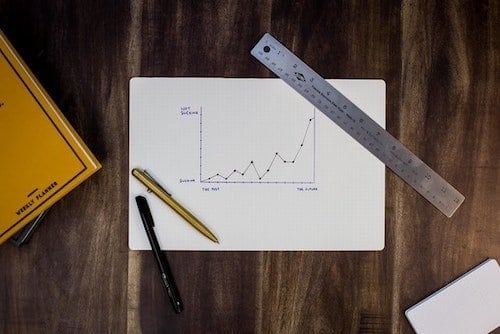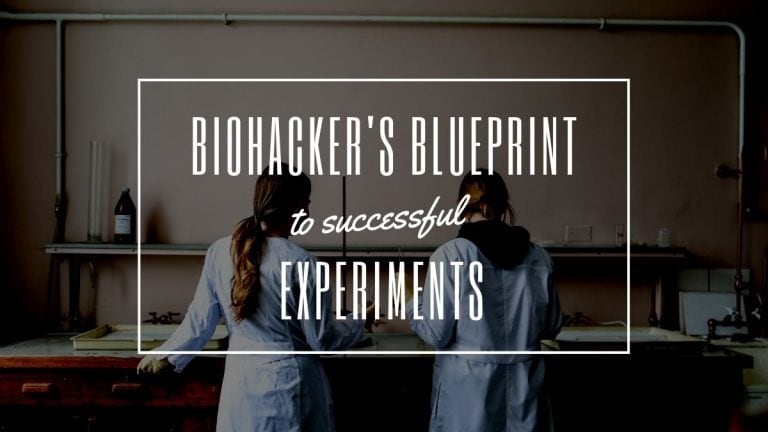“How do I know it’s working?”
— Every biohacker trying something new.
The health optimization scene is daunting. You’re sifting out gold from rivers of snake oil. There are at least two approaches to doing so:
- Chase everything that sparkles, and hope all goes well.
- Devise a simple plan, spend a few minutes logging, and follow a proven method.
You choose one of the paths for every new supplement, gadget, software, NASA-backed product, latest technology, or device that you come across.
Both can work. Most people elect option number one. You’ll save a few minutes initially, but you’re taking a shot in the dark.
Option two isn’t as quick. Your notes become precious days, weeks, and months down the line.
We do this through self-quantification, but don’t let that scare you. You can run your own biohacking experiments for free, with nothing but a pen and a few sentences. I use a framework to track every new health optimization protocol.
Why You Should Track Your Biohacking Experiments

I listen to a lot of podcasts. Inventors do a good job pitching their breakthrough biohacks. By the end of the episode, sometimes I’m sold.. until I see the price. The host and guest discuss the idea, research, and even testify how it changed their life.
Can—or should—I expect the same?
There might be more to the story than meets the eye:
- Financial interest. They probably benefit from the product selling.
- Different biology. Even identical twins have different expressions of their genes. What works for one might not for another.
- Sensitivity. We all have different thresholds and tolerances. From caffeine to chemicals, and different foods. Biohacks are no different.
- Goals. Do you want exactly the same thing they do and for the same reason?
This barely scratches the surface. One person’s great biohack can be another’s nightmare.
Memory fades. And warps.
Each time you recall a memory, you inadvertently tweak it ever so slightly. Click To TweetThat’s why you’ll visualize a scene countless times, and when you see the real thing or a photo, you swear something’s off. Now imagine your sleep, for example. Improving one percent every night might not feel like much. Over the course of a month or two, you’re sleeping far better.
The more gradual the change, the more important your baseline.
1. Determine Focus
You’ve decided to try something new. You want it to work.
Now, on to the important question.
What to try?
Biohackers generally take one of two approaches to working on health:
- Novel: knowing what new experiment to test, and now it’s time to implement. Say trying Red Light Therapy.
- Important: Focusing on an overall biohacking wellness category, without the exact means yet. Like improving sleep, for example.
Unsurprisingly, I prefer the “important” approach. It’s easy to get caught in the hype and excitement around a product or technology, and that’s okay. Know that you likely will overlook something possibly more effective, sustainable, or cheaper.
Option two takes more work, but comes with greater reward. To do so, we reverse engineer our health.
2. Reverse Engineer Your Outcome
With your focus defined, it’s time to set a goal.
Make it clear.
The more nebulous your goal, the harder your decision to continue or stop.
“Take a 2 minute cold shower every day” beats “try something uncomfortable“.
I’m working on my sleep. So I define what that means. My goal is to sleep eight hours nightly with a sleep score of 80+ as measured by my Oura wearable.
My goal is clear. I now work backward from my success to today.
Do this by asking questions:
- What changes do I need to make to improve my score to that level?
- Are those changes big or small?
- How much time should I allocate to this experiment every day?
For daunting projects, you can start small and work your way up. For example, I started my daily meditation practice at just a few minutes per session. Over months, I worked up to 20 to 30 minutes.
Starting small helps you form new habits in the difficult initial stages. Tack it on to an existing habit or routine. Otherwise, it’s easy to forget. I meditate just after drinking my morning glass of water every day.
With a clear and concise outcome in mind, log an initial baseline.
3. Establish Your Baseline
If you do nothing else, take a baseline.
Days, weeks, or months deep into your experiment, it pays off. You’ll want contrast to your current state.
What your baseline looks like will vary. There aren’t many hard and fast rules.
Broadly speaking, you can group data into: qualitative, and quantitative. Or, in other words:
- Photos for a before/after comparison. Useful for diets, supplements, fitness plans, therapies.
- Numbers like weight, body fat, ketones, blood markers.
- Descriptions such as energy levels, mood, how you feel.
In addition to the above, I like to sit down and log a journal entry that I later reflect on. Stream-of-consciousness, I let it all out. That way I have a thorough reference document to compare progress to.
I’ve made my mistakes.
More than once I took lackluster baselines, and trouble deciphering cryptic short-hand notes. Months later I couldn’t tell if I made any progress.
Since then I’ve taken better notes. You can never have too thorough of a baseline.
4. Start Logging Your Experiment
You’re all set to dive in.
Decide on a cadence to record measurements. It’s a fine balance:
- Too often and you risk logging burnout.
- Not often enough and you won’t have rich data.
I lean slightly towards less manual data collection. I do have automations and systems to data capture for me.
You can use a spreadsheet if you’re comfortable. It doesn’t need to be complicated. Or you can just handwrite everything in a journal. Recording data on the computer makes generating graphs and charts easier.
5. Analyze Your Results
You’re done. Congrats, you made it all the way through your experiment.
Log an “after” journal entry, any relevant data, and a photo if it makes sense.
You’ll instantly know whether you completed some goals. For others, it’s not so clear.
That pile of data you collected and your baseline (you completed a baseline, right?) come in handy. You get to compare that to the start and see your progress. I like to make it visual. For:
- For numbers I use charts.
- For words I use word clouds.
What kind of progress did you make? Was it worth the additional resources?
Odds are you sacrificed something important for the experiment. Time and resources at least.
Keep or Toss & Continue

Whether you accomplished your goal or came up just short, it’s time to decide next steps.
After reviewing the journey, you can decide to abandon the experiment. Or go back and repeat the process. Both are totally acceptable.
You have other commitments, so inevitably you’ll embrace some technologies, and drop others.
Using an experimentation framework weeds out what doesn't work while saving you time, money, and precious resources. Click To TweetThere are lots to learn, and the biohacking community strengthens from each shared experience. You can find more information about self-quantification here.



